Many schools will use term 4 to announce their extracurricular activities for 2026, but the smart ones will use term 3 to think more strategically about how they can increase student participation right now. Now is a prime opportunity to not only improve how your school manages admin and payments, but to drive higher student enrolment in extra-curricular activities.
A well-designed selection process helps families commit earlier and more often, while integrated payments and streamlined workflows reduce friction for staff. For schools, this can mean increased revenue, which opens the door to expanding program offerings, or introducing new activities. This creates a cycle where more opportunities for students increases the number of students participating.
This guide will show you how you can make the most of Clipboard's Activity Selection module and use the data in Clipboard to demonstrate to school leadership that students are thriving beyond the classroom.
What's covered:
- Starting with the Big Picture, looking back on the year so far
- Section 1: Process and Admin - Building the Foundation for Growth
- Section 2: Marketing and Communications - Attracting and Engaging Families
- Section 3: Finances - Easier payments, less admin
- Sharing the wins with leadership
Start with the Big Picture
Before diving into the specifics, take a moment to consider your school's overall extracurricular program. What worked well in 2025? What challenges did you face?
Also, consider your participation requirements carefully. Think about minimum participation levels across departments, how you might encourage students to try new activities, and ways to maintain a healthy balance across sports, arts, and other co-curricular offerings. Coordinating with other departments means that less students are not enrolling because of clashes.
Most people don't realise that many of the things necessary to overcome the challenges of 2025, can already be found in Clipboard. You just need to know where to look.
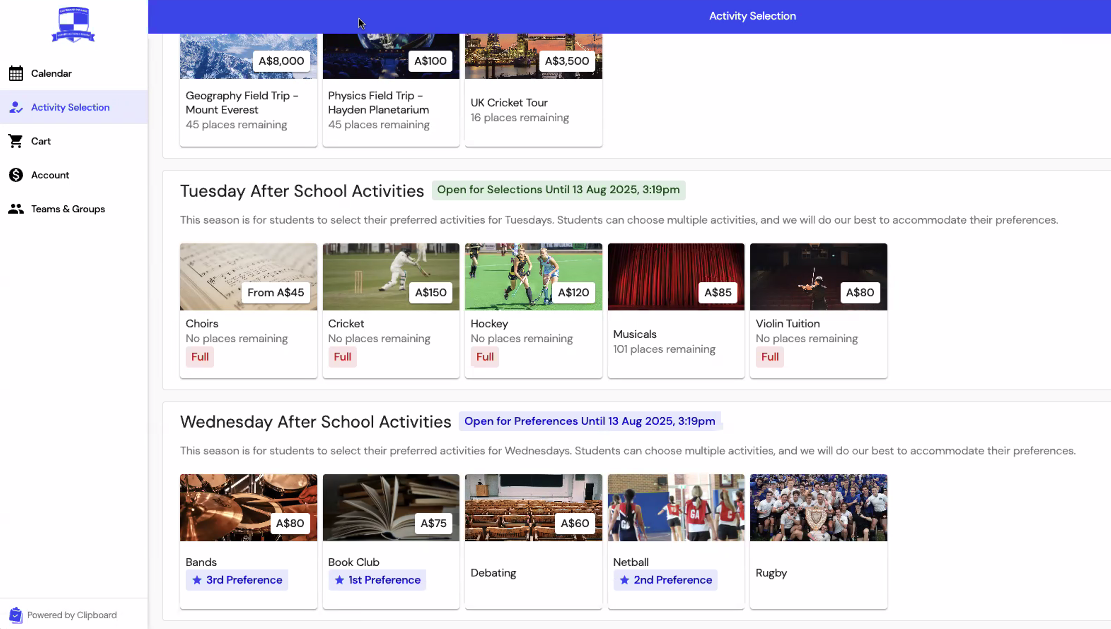
Choose Your Selection Mode and Process
🎯 New to Clipboard: Preferential Activity Selection in Clipboard feature is now available, revolutionising how international schools and diverse communities handle enrolment fairness.
As of August, all schools using Clipboard can toggle between two powerful enrolment modes, using different approaches for different activities within the same term.
Preferential Selection Mode
Perfect for international schools and high-demand activities, this system allows guardians to rank a child's preferences, eliminating the time-zone lottery that frustrates families. Parents submit ranked preferences (1st, 2nd, 3rd choice) during a multi-day window, and a smart algorithm fairly allocates spots.
When to use:
- Your parent community might span multiple time zones - International families no longer need to set alarms at difficult times to secure spots, creating truly equitable access.
- High-demand activities create stress and complaints - Remove the "fastest finger first" pressure that leads to frustrated parents and unfair outcomes.
- You want data on true activity demand - See exactly which activities families really want, not just which ones had spots available when they logged in.
- Fair access is a priority - Ensure working parents, travelling families, and those in different time zones all have equal opportunity.
How it works:
- Set selection window and communicate with families - Give families adequate time to discuss options and submit thoughtful choices rather than rushed decisions.
- Parents rank choices at their convenience - They can log in anytime during the window to submit and adjust their preferences without penalty.
- The algorithm allocates spots fairly - The system considers all preferences simultaneously and distributes spots optimally across all families.
- Staff review and adjust - Maintain control with the ability to make manual adjustments for special circumstances before confirming.
- You can switch to 1st-come, 1st-served selections for the remaining spots - Any unfilled places become available on a first-come basis after preference allocations are confirmed.
Traditional 1st-come, 1st-served selections
Still valuable for activities with unlimited capacity and remain an important way to manage enrolments for a lot of schools and activities.
💡 Pro Tip: If you are still unsure, experiment using Preferential selection for only one high-demand activity and first-come, first served mode for the rest—all in the same term! Then you can reassess a wider rollout.
Customise Your Requirements
The challenge in the past has been that there can be scenarios where students are accidentally given access to sign up for an activity when they shouldn't. For example, they don't have the right skill level, they have been prohibited from enrolling due to a previous injury or disciplinary reasons... The list goes on.
Clipboard makes things easy with two powerful tools that work together to gather essential information and control access:
Tags
The way you configure tags is up to you. Here are just a handful of examples to get the wheels turning:
- For sport: when certain students can make selections or show interest in trying out for the 1st Team
- For music: when students who want to audition for small ensembles need to be part of a large ensemble already
- For sport: When only 'elite athletes' can partake in Strength & Conditioning on Mondays
- When only a specific group of students you've previously spoken to should see a certain Activity for selection.
Generally speaking, a Tag-based requirement allows you to accommodate just about any use case in Activity Selection.
💡 Pro Tip: You can also set up Tag-based Activity Selection to 'exclude' or prohibit students from being eligible for an Activity.
Custom Fields
Custom fields capture essential information during the activity selection process and allow you to capture information as people sign up.
- Medical and trip information - Collect critical details like emergency contact information, medical allergies, and dietary restrictions when parents sign up students for school trips or activities requiring special accommodations.
- Streamlined data collection - Custom fields eliminate the need to separately ask parents for important details after activity selection, as all necessary information is captured during the enrolment process.
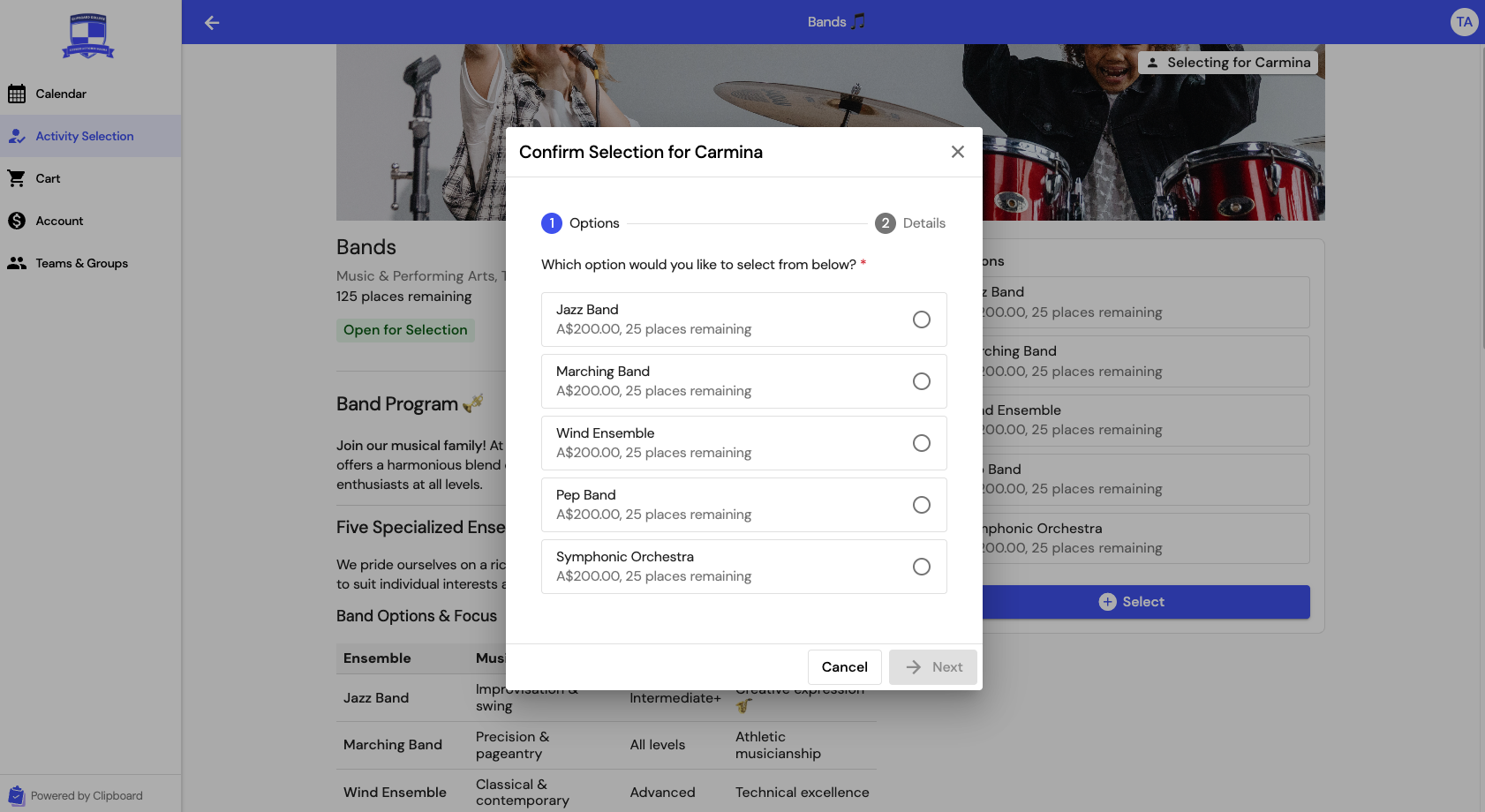
Managing Capacity and Demand
Effective capacity management is crucial for running successful extracurricular program. Using maximum place settings in 1st-come, 1st-served selections ensures activities don't exceed available resources, while having automatic waitlist management handles overflow seamlessly.
If you choose to use Preferential selection, you're not just seeing that tennis is full—you're seeing that 40 additional students listed it as their first choice. This demand visibility transforms planning, helping identify where to expand programs or add sessions.
Coordinated Scheduling with Other Departments
When all departments use the same system, you gain complete visibility into student commitments. Clash detection automatically prevents double-booking while helping identify overcommitted or unengaged students for pastoral support.
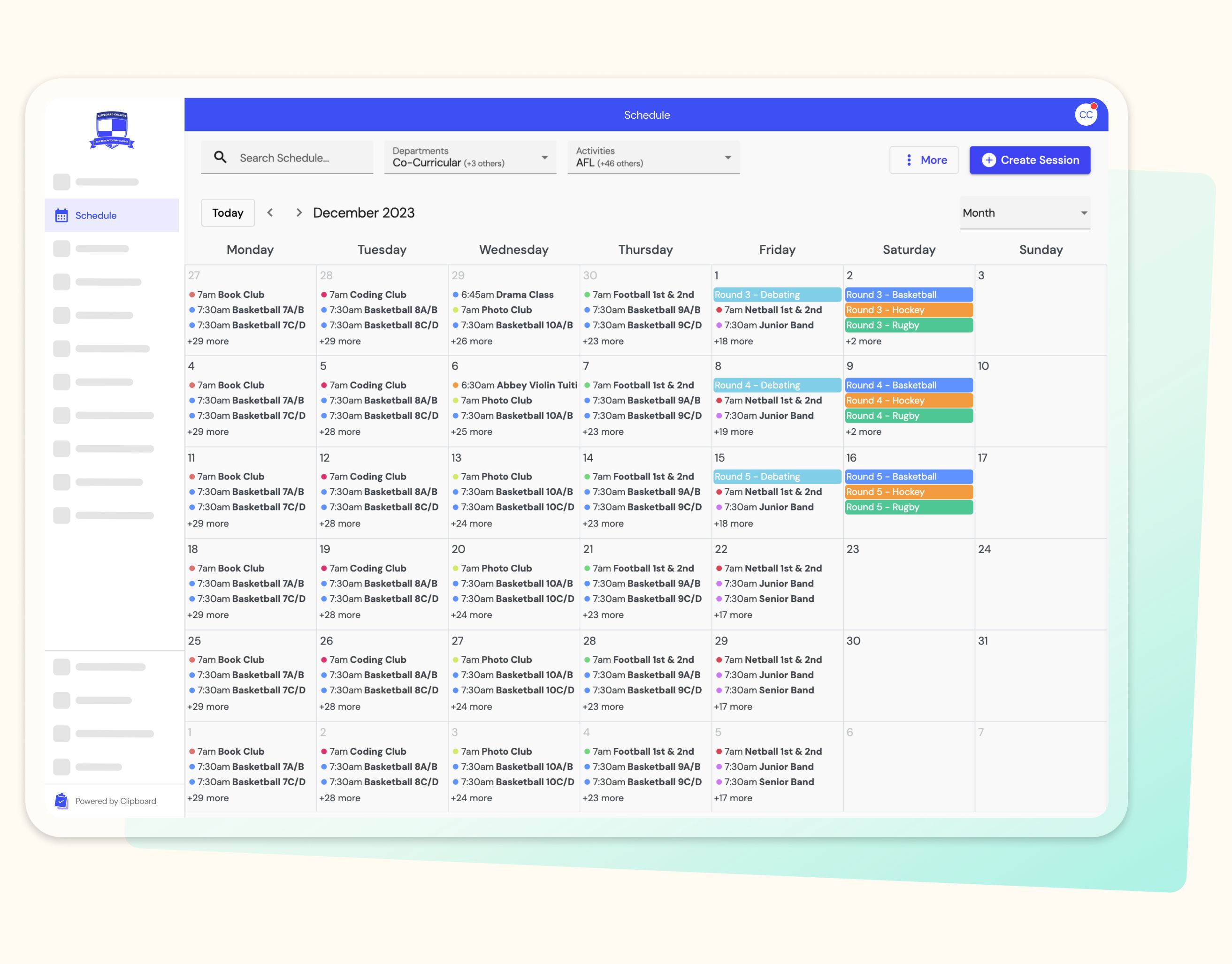
Strategic Timing
With preferential selection, timing strategies shift from creating priority windows to allowing thoughtful decision-making.
Flexible Options
Accommodate different student cohorts with tailored offerings:
- Trial periods for expensive activities - Let students try out or attend one or more sessions before paying full-season fees, reducing barriers to trying new things.
- Tiered pricing for different year levels - Reflect actual cost differences like longer training sessions or competition travel for older students.
- Inclusive options for all abilities - Ensure every student can participate regardless of skill level or physical capabilities.
Section 2: Marketing and Communications - Attracting and Engaging Families
Think of your Activity Selection module as your school's online shop window for extracurricular activities—if families don't know what's available, when to browse, or how amazing your offerings are, those spots will remain empty. Just as successful online retailers invest heavily in showcasing their products with compelling descriptions, high-quality images, and strategic promotions, your extracurricular program needs the same marketing attention to thrive. The schools seeing the highest participation rates understand this: they're not just opening registrations and hoping for the best—they're creating buzz, building anticipation, and making it easy for families to say "yes" to participation.
Clear Communication
In Activity Selection, you can use rich text editing to include detailed descriptions in your activity listings and add a bit of style. The more information families have upfront, the smoother the selection process will be.
Essential information to include:
- Competition/performance dates - Make sure to include any relevant information about important dates that fall outside of regular weekly training or rehearsals. Allow families to check for conflicts before committing, reducing later withdrawals. Things like finals or end-of-term music performances.
- Equipment requirements and costs - Be transparent about additional expenses so families can budget appropriately. Music families need to know about instrument rental or purchase costs, art club members need supply lists, robotics participants might need laptops, and sports players need uniform and equipment details.
- Links to relevant policies - Provide easy access to behaviour expectations, refund policies, and safety protocols. Music programs should link to practice expectations, clubs might include attendance requirements, and all activities need clear safety guidelines and supervision arrangements.
Choosing Images That Sell Your Activities
The right image can be the difference between a fully subscribed activity and one struggling to fill spots. When parents and students scroll through your Activity Selection module, they're making split-second decisions based on what catches their eye, just like browsing any online marketplace. Avoid generic stock photos or blurry snapshots; instead, showcase real students actively engaged in the activity, capturing the energy and enjoyment that participants experience. For sports, show action shots of students mid-game or celebrating with teammates. For music, capture the focus of a rehearsal or the excitement of a performance. For clubs and academic activities, highlight collaboration and achievement. Remember to update images regularly. Nothing undermines credibility faster than recognising students who graduated three years ago! Consider the emotional response you want to evoke: parents should see their child thriving in that environment, making friends, developing skills, and having fun.
Communication with Parents and Guardians is Critical
- Give them plenty of warning - Parents are short on time and often struggle to deal with last-minute requests. Give families time to discuss options and prepare payment methods.
- Window opening announcement - Ensure everyone knows selections are live. Use every channel you have available to you.
- 24 hours before closing - Sending out a final reminder prevents families from missing out due to forgetfulness.
- Confirmation of selections/allocations - Immediate confirmation reduces anxiety and provides clear next steps.
Making Data Work for You
Clipboard's analytics provide valuable insights for your planning process. Track selection patterns to understand student preferences, identify participation gaps, and monitor capacity utilisation across activities.
Key metrics to monitor:
- Participation rates by year level and demographic - Identify underserved groups and tailor programs to increase engagement.
- Activity popularity trends over time - Spot emerging interests and declining programs to adjust offerings accordingly.
- Capacity utilisation and waitlist demand - Make data-driven decisions about expanding popular programs or consolidating others.
- Preference patterns (with preferential selection) - See true demand beyond just what students could access in first-come systems.
Use this data to make informed decisions about program expansion, resource allocation, and pricing strategies.
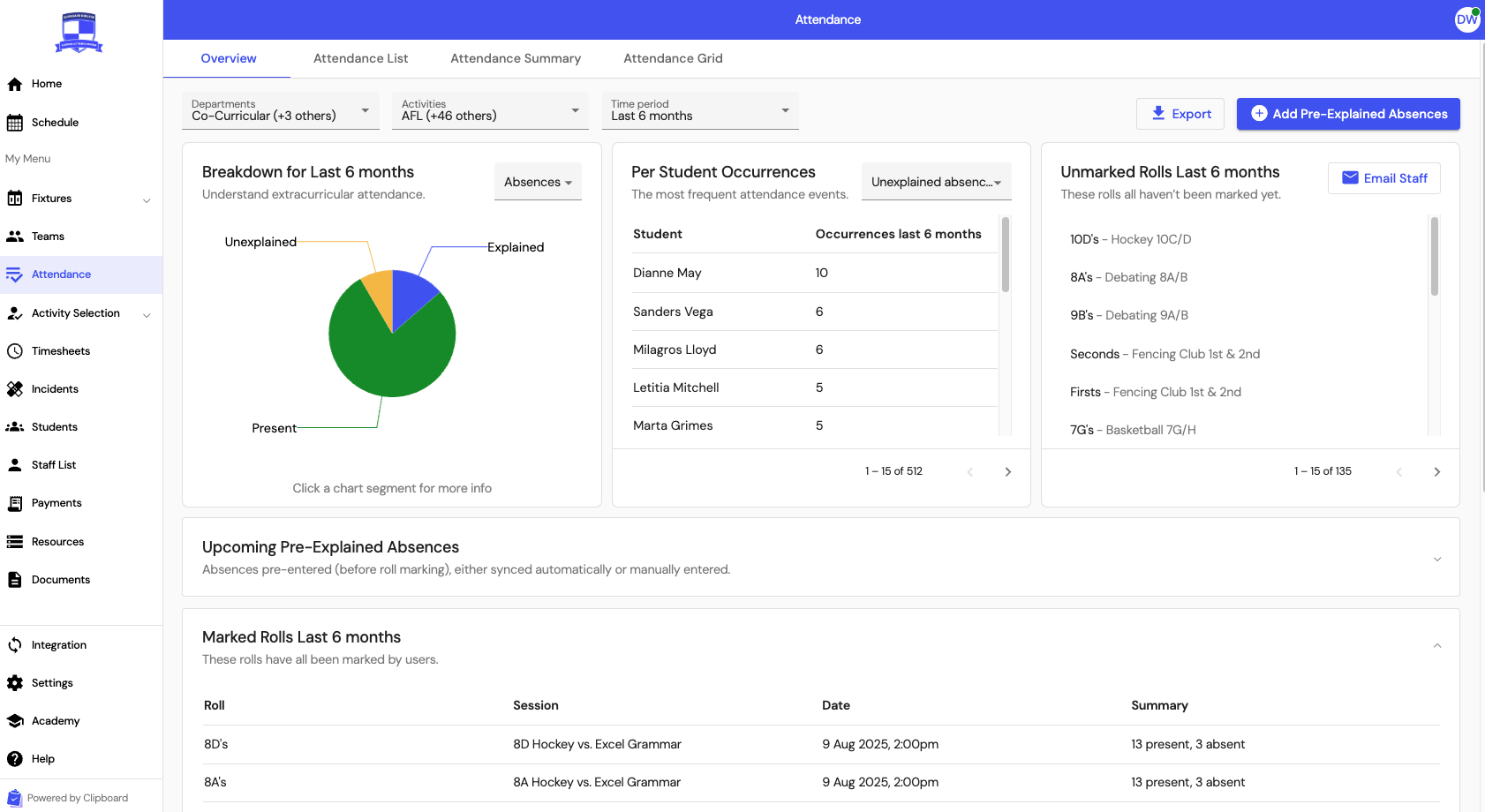
Sharing Wins
One of the most underrated features of Clipboard is the data it provides to showcase your program's impact. These insights prove invaluable when communicating with school leadership and stakeholders.
For Senior Leadership
Highlight metrics that demonstrate program value:
- Overall participation rates and growth trends (Attendance module) - Show how your programs engage the student body and grow year over year.
- Revenue generation and cost recovery (Payments module) - Demonstrate financial responsibility and contribution to school resources.
- Cross-departmental engagement - Illustrate how activities support whole-child development across disciplines with every department on board.
For Other Departments
Share insights that foster collaboration:
- Resource optimisation opportunities (Resources module) - Identify shared equipment or venue usage to maximise budgets.
- Activity conflict analysis - Work together to minimise scheduling conflicts between departments.
Section 3: Finances - Increasing Revenue Through Strategic Management
Upfront Payments
Taking payments upfront transforms your financial operations and eliminates the chase for unpaid invoices. When families make financial commitments at selection, schools report significant reduction in no-shows and improved cash flow.
To learn more about this game-changing approach, check out this article for five reasons why upfront payments save both time and money.
Financial Sustainability
Running a successful extracurricular program isn't just about participation—it's about financial sustainability. Many schools find that careful cost management is crucial for program longevity.
Cost Analysis Essentials
When setting up your activity selection process, implement a thorough cost analysis, including:
Direct costs:
- Equipment and materials - Calculate per-student costs for consumables and factor in equipment replacement cycles.
- Coaching staff - Include wages, on-costs, and professional development expenses.
- Transportation - Budget for regular training transport plus competition travel.
- Venue hire - Account for both regular training venues and special event locations.
Indirect costs:
- Facility maintenance - Allocate appropriate portions of field maintenance, court resurfacing, and general upkeep.
- Administrative overhead - Factor in the time spent on scheduling, communication, and program management.
- Insurance - Ensure adequate coverage for all activities and participant numbers.
Revenue Optimisation
Consider these strategies for financial sustainability:
- Break-even analysis to determine minimum viable participants - Know exactly how many students you need to make each activity financially viable.
- Tiered pricing reflecting different resource requirements - Charge appropriately for high-cost activities while keeping basic programs accessible.
- Early bird discounts (10-15% for advance registration) - Incentivise early commitment while improving your planning capacity.
- Family discounts are automatically calculated - Encourage whole-family participation while maintaining revenue targets.
- Clear cancellation policies to manage financial risk - Protect against last-minute withdrawals that leave you with committed costs.
💡 Pro Tip: Remember, while keeping activities accessible is important, undercharging can lead to program cuts. Schools find success offering a mix of premium and standard options, maintaining overall sustainability while ensuring broad participation.
Looking Ahead
As you implement your 2026 Activity Selection plan, remember that the goal is to create an enriching extracurricular program that's accessible and enjoyable for all students while being manageable for staff.
Implementation Checklist
- Review 2025 data and identify improvements
- Configure selection modes (preferential vs. 1st-come, 1st-served selections)
- Update activity information and images
- Train staff on new features
- Launch Term 1 selections
- Monitor submissions and preferences
- Review and adjust allocations
- Confirm enrolment with students and parents
Ongoing:
- Weekly monitoring during selection periods
- Monthly participation tracking
- Termly financial reviews
- Annual strategic planning
💡 Pro Tip: Early planning leads to better participation, smoother administration, and ultimately, a more successful extracurricular program for your school community.
Ready to Get Started?
For Current Clipboard Users:Log into your Clipboard dashboard and begin setting up your Activity Selection module for 2026. Need help? Check out Activity Selection in Clipboard Academy, or reach out to our support team.
Not Yet Using Activity Selection?Every day without modern activity selection means hours of unnecessary work and missed opportunities. Schedule a demo to see how Activity Selection can transform your school's extracurricular program.
Your students deserve the best opportunities. Your parents deserve a fair process. Your staff deserves tools that make their jobs easier. Make 2026 the year you deliver on all three.

.jpg)
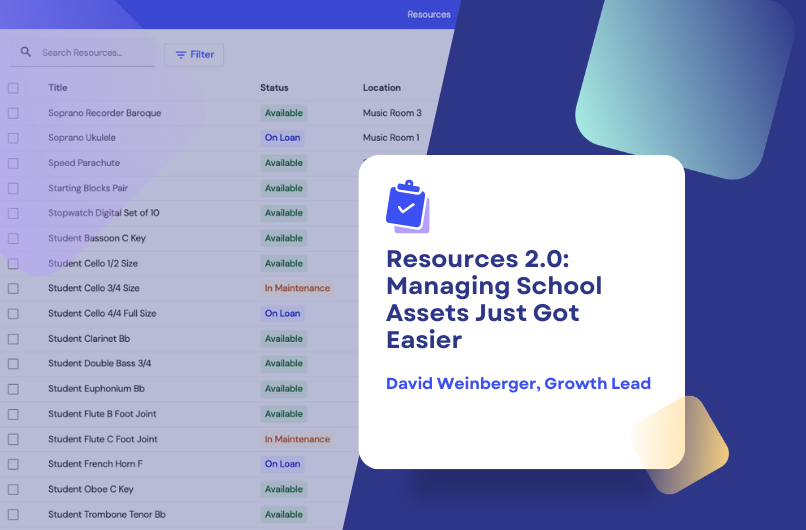
.jpg)
.png)
.jpg)







